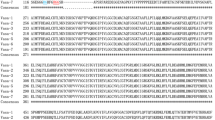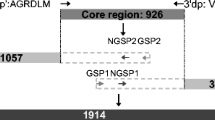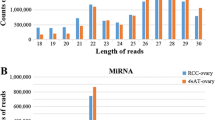Abstract
The sea louse Caligus rogercresseyi is a major ectoparasitic copepod that causes significant economic losses in the salmon farming industry. Despite recent advancements, the mechanisms underlying germline and embryo development in this species remain poorly understood. The Vasa gene encodes a highly conserved DEAD box helicase that is required for germ cell formation and function in many species. In this study, the Vasa gene was characterized in C. rogercresseyi, and its expression and function were analyzed. Phylogenetic analysis showed that the Cr-Vasa gene product formed clusters in clades with Vasa proteins from closely related species of crustaceans. Cr-Vasa gene expression patterns were assessed by qPCR, and the results showed a significantly higher relative expression level in adult females compared to copepodid, chalimus, and adult male stages. Tissue-specific localization of Cr-Vasa mRNA in C. rogercresseyi was determined using chromogenic in situ hybridization, and strong positive signal was observed in male testes, but also in the intestine and cuticle, while in females, it was observed in the ovaries, oocytes, cuticle, intestine, and egg strings. RNAi-mediated gene silencing of Cr-Vasa impacted embryonic development and reproductive output in adult female lice. Females from the dsVasa-treated group displayed unusual phenotypes, including shorter egg strings with numerous extra-embryonic inclusions, irregularly shaped abnormal embryos, and aborted egg strings. This study provides insights into the role of the Vasa gene in C. rogercresseyi embryonic development and reproductive output, which may have implications for the control of this parasitic copepod in the salmon farming industry.







Similar content being viewed by others
Data Availability
The data that support the findings of this study are available from the corresponding author upon reasonable request.
References
Aflalo ED, Bakhrat A, Raviv S, Harari D, Sagi A, Ddu U (2007) Characterization of a Vasa-like gene from the Pacific white shrimp Litopenaeus Vannamei and its expression during oogenesis. Mol Reprod Dev 74:172–177
Andersen CL, Jensen JL, Ørntoft TF (2004) Normalization of real-time quantitative reverse transcription-PCR data: a model-based variance estimation approach to identify genes suited for normalization, applied to bladder and colon cancer data sets. Cancer Res 64:5245–5250
Bravo S (2010) The reproductive output of sea lice Caligus rogercresseyi under controlled conditions. Exp Parasitol 125:51–54
Bustin SA, Benes V, Garson JA, Hellemans J, Huggett J, Kubista M, Mueller R, Nolan T, Pfaffl MW, Shipley GL, Vandesompele J, Wittwer CT (2009) The MIQE guidelines: minimum information for publication of quantitative real-time PCR experiments. Clin Chem 55:611–622
Bustos P, Schmitt P, Brown DI, Farlora R (2023) RNA interference-mediated silencing of retinoid X receptor causes reproductive failure in the sea lice Caligus rogercresseyi. Aquaculture 566:1–12
Carrera P, Johnstone O, Nakamura A, Casanova J, Jäckle H, Lasko P (2000) VASA mediates translation through interaction with a Drosophila yIF2 homolog. Mol Cell 5:181–187
Costello MJ (2009) The global economic cost of sea lice to the salmonid farming industry. J Fish Dis 32:115–118
Dalvin S, Nilsen F, Skern-Mauritzen R (2013) Localization and transcription patterns of LsVasa, a molecular marker of germ cells in Lepeophtheirus salmonis (Krøyer). J Nat Hist 47:889–900
Dehghani M, Lasko P (2017) Multiple functions of the DEAD-box helicase vasa in Drosophila oogenesis. Results Probl Cell Differ 63:127–147
Diao Y, Hua M, Shao Y, Huang W, Liu M, Ren C, Ji Y, Chen J, Shen J (2015) Preliminary characterization and expression of Vasa-like gene in Schistosoma japonicum. Parasitol Res 114:2679–2687
Dresdner J, Chávez C, Quiroga M, Jiménez D, Artacho P, Tello A (2019) Impact of Caligus treatments on unit costs of heterogeneous Salmon farms in Chile. Aquac Econ Manag 23:1–27
Durdevic Z, Pillai RS, Ephrussi A (2018) Transposon silencing in the Drosophila female germline is essential for genome stability in progeny embryos. Life Sci Alliance 1(5):1–9
Durdevic Z, Ephrussi A (2019) Germ cell lineage homeostasis in Drosophila requires the vasa RNA helicase. Genetics 213:911–922
Fabioux C, Huvet A, Lelong C, Robert R, Pouvreau S, Daniel JY, Minguant C, Le Pennec M (2004) Oyster vasa-like gene as a marker of the germline cell development in Crassostrea gigas. BBRC 320:592–598
Farlora R, Araya-Garay J, Gallardo-Escárate C (2014) Discovery of sex-related genes through high-throughput transcriptome sequencing from the Salmon louse Caligus rogercresseyi. Mar Genomics 15:85–93
Farlora R, Nuñez-Acuña G, Gallardo-Escárate C (2015) Prohibitin-2 gene reveals sex- related differences in the salmon louse Caligus rogercresseyi. Gene 564:73–80
Farlora R, Valenzuela-Muñoz V, Chávez-Mardones J, Gallardo-Escárate C (2016) Aquaporin family genes exhibit developmentally-regulated and host-dependent transcription patterns in the sea louse Caligus rogercresseyi. Gene 585:119–127
Gallardo-Escárate C, Arriagada G, Carrera C, Gonçalves AT, Nuñez-Acuña G, Valenzuela-Miranda D, Valenzuela-Muñoz V (2019) The race between host and sea lice in the Chilean Salmon farming: a genomic approach. Rev Aquac 11:325–339
Gallardo-Escárate C, Valenzuela-Muñoz V, Nuñez-Acuña G, Valenzuela-Miranda D, Gonçalves AT, Escobar-Sepulveda H, Liachki I, Nelson B, Roberts S (2021) Chromosome-scale genome assembly of the sea louse Caligus rogercresseyi by SMRT sequencing and Hi-C analysis. Sci Data 8:1–12
Gavis ER, Lehmann R (1994) Translational regulation of nanos by RNA localization. Nature 369:315–318
Gonçalves AT, Farlora R, Gallardo-Escárate C (2014) Transcriptome survey of the lipid metabolic pathways involved in energy production and ecdysteroid synthesis in the salmon louse Caligus rogercresseyi (Crustacea: Copepoda). Comp Biochem Physiol B 176:9–17
Gruidl M, Smith PA, Kuznicki KA, McCrone JS, Kirchner J,Roussell DL, Strome S, Bennett KL (1996) Multiple potential germline helicases are components of the germline-specific P granules in C. elegans. PNAS 93(24): 13837–13842
Hay B, Jan LY, Jan YN (1988) A protein component of Drosophila polar granules is encoded by vasa and has extensive sequence similarity to ATP-dependent helicases. Cell 55:577–587
He S, Zhu L, Liu F, Liu Q, Shao Y, Hua M, Ding H, Shao W, Du Y, Hou X, Ren C, Liu M, Shen J (2018) Functions of the Vasa gene in Schistosoma japonicum as assessed by RNA interference. Gene 638:13–19
Hidalgo-Cabrera A, Bustos P, Vidal-Pérez D, Schmitt P, Brokordt K, Brown DI, Farlora R (2022) Analysis and gonadal localization of speedy a mRNA transcript, a novel gene associated with early germline cells in the scallop, Argopecten purpuratus. Anim Reprod Sci 236:1–14
Knaut H, Pelegri F, Bohmann K, Schwarz H, Nüsslein-Volhard C (2000) Zebrafish vasa RNA but not its protein is a component of the germ plasm and segregates asymmetrically before germline specification. JCB 149:875–888
Kobayashi T, Kajiura-Kobayashi H, Nagahama Y (2000) Differential expression of vasa homologue gene in the germ cells during oogenesis and spermatogenesis in a teleost fish, tilapia. Oreochromis Niloticus Mech Dev 99:139–142
Komiya T, Itoh K, Ikenishi K, Furusawa M (1994) Isolation and characterization of a novel gene of the DEAD box protein family which is specifically expressed in germ cells of Xenopus laevis. Dev Biol 162:354–363
Lasko P (2013) The DEAD-box helicase Vasa: evidence for a multiplicity of functions in RNA processes and developmental biology. BBA Gene Regulatory Mechanisms 1829:810–816
Li CJ, Liu L, Chen XH, Zhang T, Gan F, Cheng BL (2010) Identification of a vasa homologue gene in grass carp and its expression pattern in tissues and during embryogenesis. Comp Biochem Physiol B 157:159–166
Livak KJ, Schmittgen TD (2001) Analysis of relative gene expression data using real-time quantitative PCR and the 2-ΔΔCT method. Methods 25:402–408
Nakkarasae LI, Damrongphol P (2007) A vasa-like gene in the giant freshwater prawn. Macrobrachium Rosenbergii Mol Reprod Dev 74:835–842
Olsen LC, Aasland R, Fjose A (1997) A vasa-like gene in zebrafish identifies putative primordial germ cells. Mech Dev 66:95–105
Özhan-Kizilet G, Havemann J, Gerberding M (2009) Germ cells in the crustacean Parhyale hawaiensis depend on Vasa protein for their maintenance but not for their formation. Dev Biol 327:230–239
Qiu GF, Chen Y, Cui Z, Zhu XL (2013) Localization of germline maker Vasa homolog RNA to a single blastomere at early cleavage stages in the oriental river prawn Macrobrachium nipponense: evidence for germ cell specification by preformation. Gene 513:53–62
Raz E (2000) The function and regulation of vasa-like genes in germ-cell development. Genome Biol 1:1–6
Rozen S, Skaletsky H (2000) Primer3 on the WWW for general users and for biologist programmers. Methods Mol Biol 132:365–386
Schwager EE, Meng Y, Extavour CG (2015) Vasa and piwi are required for mitotic integrity in early embryogenesis in the spider Parasteatoda tepidariorum. Dev Biol 402:276–290
Styhler S, Nakamura A, Swan A, Suter B, Lasko P (1998) Vasa is required for GURKEN accumulation in the oocyte, and is involved in oocyte differentiation and germline cyst development. Development 125:1569–1578
Tomancak P, Guichet A, Zavorszky P, Ephrussi A (1998) Oocyte polarity depends on regulation of gurken by Vasa. Development 125:1723–1732
Toyooka Y, Tsunekawa N, Takahashi Y, Matsui Y, Satoh M, Noce T (2000) Expression and intracellular localization of mouse Vasa-homologue protein during germ cell development. Mech Dev 93:139–149
Wagner DE, Ho JJ, Reddien PW (2012) Genetic regulators of a pluripotent adult stem cell system in planarians identified by RNAi and clonal analysis. Cell Stem Cell 10:299–311
Wang M, Ding H, Wu S, Wang M, Wei C, Wang B, Bao Z, Hu J (2022) Vasa is a potential germ cell marker in leopard coral grouper (Plectropomus leopardus). Genes 13:1–15
Wang Y, Chen Y, Han K, Zou Z, Zhang Z (2012) A vasa gene from green mud crab Scylla paramamosain and its expression during gonadal development and gametogenesis. Mol Biol Rep 39:4327–4335
Wessel GM (2016) Germ line mechanics – and unfinished business. Curr Top Dev Biol 117:553–566
Westfall PH, Henning KSS (2013) Texts in statistical science: understanding advanced statistical methods, 1st edn. CRC Press, New York
Yajima M, Wessel G (2011b) The DEAD-box RNA helicase Vasa functions in embryonic mitotic progression in the sea urchin. Development 138:2217–2222
Yajima M, Wessel GM (2011a) The multiple hats of Vasa: its functions in the germline and in cell cycle progression. Mol Reprod Dev 78:861–867
Yajima M, Wessel GM (2015) Essential elements for translation: the germline factor vasa functions broadly in somatic cells. Development 142:1960–1970
Zhou L, Wang X, Du S, Wang Y, Zhao H, Du T, Yu J, Wu L, Song Z, Liu Q, Li J (2020) Germline specific expression of a vasa homologue gene in the viviparous fish black rockfish (Sebastes schlegelii) and functional analysis of the vasa 3′ untranslated region. Front Cell Dev Biol 8(575788): 1–15
Acknowledgements
We are grateful to Sandra Marin, Melinka Mancilla, and Nitza Vera at Laboratorio de Interacciones Ecológicas, Universidad Austral (Chile), for their sea lice culture assistance and to Sussie Dalvin at the Institute of Marine Research (Norway) for her recommendations regarding the RNAi experiment.
Funding
This study was supported by the ANID-Chile FONDECYT 11150915 and FONDEF ID21I10276 granted to Rodolfo Farlora and ANID-Chile “BECA DE DOCTORADO NACIONAL” No. 21170548 granted to Paulina Bustos. Paulina Bustos and Rodolfo Farlora were also supported by the Centro de Investigación y Gestión de Recursos Naturales (CIGREN) CIDI-UV and the Programa de Apoyo a la Adquisición de Equipamiento Menor from the Universidad de Valparaíso, Chile.
Author information
Authors and Affiliations
Contributions
Paulina Bustos: Conceptualization, methodology, investigation, data curation, formal analysis, writing—original draft, visualization. Paulina Schmitt: Conceptualization, resources, writing—review and editing. Donald Irving Brown: Conceptualization, methodology, resources, writing—review and editing. Rodolfo Farlora: Conceptualization, methodology, resources, writing—review and editing, supervision, project administration, funding acquisition. All authors contributed to the article and approved the submitted version.
Corresponding author
Ethics declarations
Conflict of Interest
The authors declare no competing interests.
Additional information
Publisher's Note
Springer Nature remains neutral with regard to jurisdictional claims in published maps and institutional affiliations.
Supplementary Information
Below is the link to the electronic supplementary material.
Rights and permissions
Springer Nature or its licensor (e.g. a society or other partner) holds exclusive rights to this article under a publishing agreement with the author(s) or other rightsholder(s); author self-archiving of the accepted manuscript version of this article is solely governed by the terms of such publishing agreement and applicable law.
About this article
Cite this article
Bustos, P., Schmitt, P., Brown, D.I. et al. Silencing of the Vasa gene by RNA Interference Affects Embryonic Development and Reproductive Output in the Sea Louse Caligus rogercresseyi. Mar Biotechnol 25, 612–623 (2023). https://doi.org/10.1007/s10126-023-10232-5
Received:
Accepted:
Published:
Issue Date:
DOI: https://doi.org/10.1007/s10126-023-10232-5




